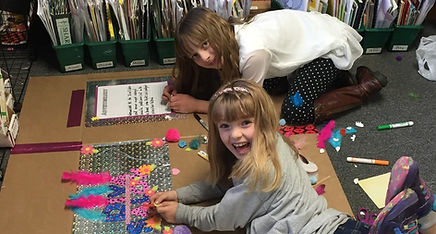
Have a gifted kid?
Check out our recommended resources!
At The Academies, we use the best practices from gifted education with all learners. The gifted education field has focused on defining the best ways to facilitate talent and intellectual development in young people, and has produced clear results, pointing to effective practices. Because all learners possess talent and intellectual strengths and weaknesses, we will apply these talent and intellectual development strategies and structures broadly; the practices designed to support exceptional learners' growth are, in fact, effective with learners of varying talent and intellectual ability. Our school will cause all learners to grow at their natural pace. We will carefully monitor data to ensure that achievement and school success is universal: those who struggle to meet standards will receive the supports and targeted instruction and interventions to continually grow toward proficiency. Those who are "on grade level" will receive multiple opportunities to practice new skills and apply concepts. And those whose demonstrated ability far outpaces their peers, too, will show continuous growth through supported challenge. Our schools show that it is truly possible in our public school system to differentiate instruction to deliver a student-responsive, standards-based education, and deliver appropriate public education to learners across the achievement spectrum.
Gifted and Talented Education Standards
Our school will consistently use strategies from the four domains of the GATE standards in all classes, with all students. These domains ask educators to adjust what is delivered to students to add elements of depth, complexity, novelty, and acceleration. In order to add this dimensionality to academic content, every teacher at The Academies receives extensive professional development from the California Association for the Gifted and at our school sites on an ongoing basis and through our instructional coaching.
Depth and Complexity (Depth and Complexity Icons)
We employ the "prompts/icons of depth and complexity" developed by Sandra Kaplan of USC as a way to develop strong and independent thinking within our learners. The icons/prompts are symbols paired with a word (such as judgment, details, ethics, multiple perspectives, trends, context, etc.) and the icons prompt the kind of thinking indicated. The icons are content-neutral. Thus, they can be used with all academic content to prompt students' thinking about the subject in deeper and more complex ways. As a result of repeated use of these in our K-8 classrooms, students will acquire these as habits of mind and will be able to think deeply, and with complexity, on their own. Our teachers teach the icons in the following scope and sequence, however they have the flexibility to act outside this guidance when a student’s ability suggests a lack of readiness, or a precociousness, that would cause the student to benefit from an adjustment of this pacing:
• Single prompts: Used in K-8
o e.g. What is the context of this problem?
• Sets: Used in grades 1-8
o e.g. What is the context of this problem and what is its impact?
• Intersections: grades 3-8
o e.g. How does the context affect the impact of the problem?
• Problem-solving: grades 5-8
o e.g. Which icons, in what order, together make a process for solving this problem or reducing its impact?
Novelty (Voice and Choice, Projects, Critical Thinking Skills, Creative Thinking Skills)
Practices associated with the GATE domain of novelty include responding to students' individual talents and strengths. Additionally, our teachers provide novelty through teaching modes of reasoning and allowing some degree of student choice. We use PBL to help us provide a rich learning experience that will always include an element of “voice and choice.” Teachers also instruct all students in critical and creative thinking skills. Critical thinking skills (such as "reason with evidence," or "determine the relevance," or "draw a conclusion") will be explicitly taught as step by step processes, so that students understand the process that each requires and are empowered as learners to use these in novel situations or for problem-solving. Creative thinking skills (such as "substitute," or "combine," or "add to," or "modify") will also be taught as ways individuals can construct new solutions or ideas using prior knowledge or materials. We consider the teaching of critical and creative thinking skills a necessary part of meeting the rigor of the CCSS and developing the kinds of thinkers who are prepared for a 21st century economy and for democratic participation.
Acceleration (Universal Concepts and Themes, Think like a Disciplinarian, High-Level Questioning)
Practices we employ from the GATE domain of acceleration include asking students questions of varying types and levels of intellectual demand, teaching students about making connections, tying ideas together through the use of universal concepts to anchor study across disciplines and increase transferability, and teaching students how to "think like a disciplinarian." Contrary to the typical understanding of the word "acceleration," which suggests simply moving quickly through curriculum, the GATE standards define acceleration as a way to differentiate instruction to promote sophisticated thinking in young students. It is really about accelerating the type of thinking we develop in students. To do this, teachers will be conscientious about when to use open-ended versus closed-ended questioning. They will teach students about factual, analytic, and evaluative questions and use a variety of these to develop different types of thinking and reasoning in their scholars. "Thinking like a disciplinarian" includes studying the methods, key concepts, questions, language/vocabulary, and contributions of an academic discipline so that its processes can be applied to construct more meaningful understanding. For example, students might "think like a historian," "think like an economist," "think like an educator," "think like a philosopher," or "think like a musician." Using this strategy to add dimension to academic content helps teachers build rich schema in learners’ minds and also produces academic enthusiasm. Students will begin to learn about themselves as learners as well, which disciplines they have affinity for or greater curiosity within, and come into contact with the myriad opportunities for careers and study in the vast fields that are available to them for further pursuit. “Thinking like a disciplinarian” models concepts that are important to impart through the process of education: that knowledge is built through the contributions of many over time, that multiple perspectives and diversity of thought is a productive virtue that produces social benefit, and that learning is a life-long and never-ending process and humility and questioning is the key to further growth and development.


